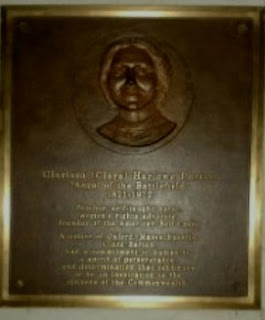Boston Public Library offers free educational exhibits
Over the past couple of years, I have viewed several innovative and thought-provoking cultural & historic exhibits at the Boston Public Library. I have seen exhibits on President John Adams, artist Allan Rohan Crite, Allexandre Vattemare – a French ventriloquist, and an exhibit recognizing the 400th anniversary of the founding of Quebec. Earlier this year in February, I visited the BPL again and on this occasion I saw three separate but important exhibits. The first exhibit was Right and Wrong in Boston: The Boston Female Anti-Slavery Society. Held in the Cheverus Room in the McKim Building, this display included documents and pictures concerning an influential abolitionist group in 19th century Boston. The BFASS’s primary mission was to assist fugitive slaves by protecting them if they escaped from their owners and advocating for their emancipation. Women of many different religious beliefs were members of the Society. Maria Weston Chapman (1806 -1885), a well known abolitionist in the 1800s, wrote the annual reports for the Society. Alexander Hamilton: The Man Who Made Modern America was another exhibit that I visited. This is a traveling exhibit created by the New-York Historical Society to commemorate the 200th anniversary of Hamilton’s death. The exhibit highlighted six components of Hamilton’s life: Economist, Futurist, Immigrant, Lawmaker, Soldier, and The Duel. Hamilton was born in the West Indies and later immigrated to New York. From 1776 to 1781, he fought as an artillery captain in seven major battles during the American Revolution. Hamilton, who was a self-taught economist, was appointed by President George Washington as the first U.S. Treasury Secretary in 1789. Hamilton helped to solve the nation’s debt problem. He also established a modernized credit system. In addition to having creative economic ideas, Hamilton was ahead of his time in other ways. Unlike many of his contemporaries, Hamilton was against slavery. Hamilton wrote on February 23, 1791: “Who talk most about liberty and equality?... Is it not those who hold the bill of rights in one hand and a whip for affrighted slaves in the other?” The Federalist Papers were a series of newspaper articles written by John Jay, James Madison, and Hamilton. The articles were written to defend the establishment of the U.S. Constitution. In October 1787, in Federalist No. 1., Hamilton wrote: “The vigor of government is essential to the security of liberty.” Although Hamilton (1757-1804) died over two hundred years ago, his legacy endures. Currently, Hamilton’s image can be seen every day. His likeness appears on the front of the U.S. $10 bill. The third exhibit that I saw was a photograph exhibit depicting the ongoing humanitarian crisis in the Darfur region of Sudan – the largest country in Africa. Darfur is home to over 30 ethnic groups, all of which are Muslims. The Darfur region is approximately the size of the state of Texas. The name Sudan is derived from the Arabic “bilad al-sudan,” which means land of the blacks. Sudan, with a population of 41 million people, has a poor infrastructure – a result of decades of fighting. In February 2003 fighting began in the western region of Darfur. The Sudanese military and the Janjaweed – a Sudanese militia group have been fighting against rebel forces such as the Sudan Liberation Movement/Army. The civil war has resulted in the deaths of between 200,000 to 400,000 civilians and displaced 2 million people. The pictorial exhibit showed images of how devastating the conflict has been on the people of Darfur. The conflict is Africa’s longest running civil war. Most small villages in the rural areas of Darfur have been deserted or destroyed. On March 4, 2009, the International Criminal Court in The Hague (Netherlands) issued an arrest warrant for Sudanese president Omar Hassan Ahmad al-Bashir for crimes against humanity in Darfur. Looking at the pictures of the deserted villages and suffering of the Sudanese civilians stirs an emotional response from an onlooker. Colin Finlay and Ron Haviv are two of the photographers whose pictures capture the harsh reality of the bitter Sudanese conflict. I also think the photographs can tell a story that words cannot. The images are lasting and hopefully they can bring more attention to the ongoing humanitarian crisis in Darfur.


The images are especially intriguing on the ones of Darfur. It really brings the viewer into the lives of the people that are struggling over there, and hopefully yes, there will be more attention to the crisis going in Darfur.
ReplyDelete